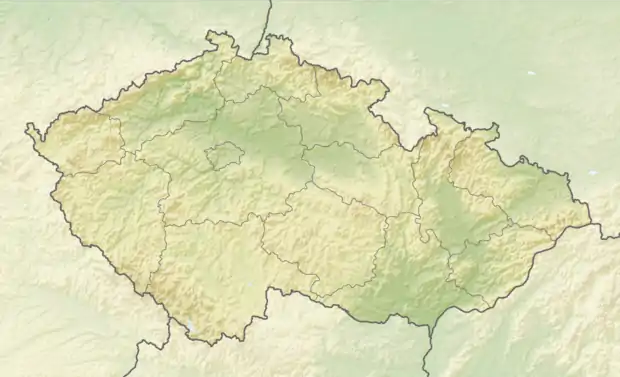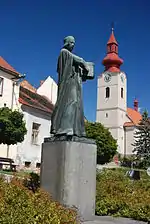Husinec, Prachatice District
Husinec (German: Hussinetz) is a town in Prachatice District in the South Bohemian Region of the Czech Republic. It has around 1,500 inhabitants. It was the birthplace of Czech theologian, Jan Hus.[2]
Husinec | |
|---|---|
Town | |
.JPG.webp) Church of the Exaltation of the Holy Cross | |
.svg.png.webp) Flag _zank.gif) Coat of arms | |
 Husinec Location in the Czech Republic | |
| Coordinates: 49°3′18″N 13°59′13″E | |
| Country | |
| Region | South Bohemian |
| District | Prachatice |
| First mentioned | 1291 |
| Government | |
| • Mayor | Ludmila Pánková |
| Area | |
| • Total | 10.34 km2 (3.99 sq mi) |
| Elevation | 504 m (1,654 ft) |
| Population (2020-01-01[1]) | |
| • Total | 1,452 |
| • Density | 140/km2 (360/sq mi) |
| Time zone | UTC+1 (CET) |
| • Summer (DST) | UTC+2 (CEST) |
| Postal code | 384 21 |
| Website | www |
History

In 942, subjects of the Fürsten of Boleslaus I, Duke of Bohemia explored the area of Husinec for gold. The first written record dates from 1291 when Heinrich Vok von Borek und Husinec (Jindřich Vok z Borku a Husince) declared his rights to the area at the District Court. In 1359, the village became a town
In the 14th century a castle was built whose ruins exist today. In 1390, the Hus Castle was taken by Sigismund von Huller und Orlík (Sigmund Huller z Orlíka), a supporter of King Wenceslaus and eventually state treasurer and King's advisor. Caught falsifying documents, however, he was beheaded. The castle was left for his brother Andreas, who a short time later sold it to the Knights of Mikuláš of Hus. This castle, in 1419, hosted a meeting of Mikuláš's supporters who were preparing for the overthrow of King Wenceslaus. The coup did not take place. In 1420, Mikuláš fell off his horse and died.
The abandoned castle was taken and plundered by the robber baron Habart from Hrádek, or Lopata from Budějovice, known as "The merchant of the Golden Trail". On September 8, 1441, landowners from surrounding towns joined together to attack and burn the castle. In 1455, the Knight Smílek from Lnáře sold his allegiance to Ulrich II of Rosenberg bringing Husinec under the rule of Winterberg.
The economy of Husinec was dependent up the trade produced by the Golden Trail trade route. Goods transported on the route included, primarily, salt, expensive clothes, wine, seafood, tropical fruits, spices, iron and weapons.
In 1601, the House of Kolowrat bought the town followed by Hans Ulrich von Eggenberg in 1630. After the Battle of White Mountain many residents of Husinec, who were followers of the reformer Jan Hus and his teachings, emigrated abroad.
From 1655 to 1848 Husinec fell under the control of the House of Schwarzenberg. At that time the village contained about 1173 inhabitants but the population increased to 1731 in 1886, 1189 in 1931 and 1800 in 1938. In 1945, Husinec was liberated by the U.S. Army. Since 12 April 2007 Husinec is a town.
Landmarks
- Birthplace of the reformer Jan Hus (Czech cultural monument)
- Family home and studio of artist Josef Krejza
- Church of the collection of the Holy Cross
- Church of St. Cyril and Methodius
- Monuments of Saint John of Nepomuk and Jan Hus
Notable people
- Jan Hus (c.1372–1415), theologian, philosopher and reformer
- Johann Pehel (1852–1926), composer
- Josef Krejsa (1896–1941), artist
- Cyril Chramosta (1908–1990), painter
- Václav Hraba (born 1938), graphic artist
- Václav Kuneš (born 1949), artist
References
- "Population of Municipalities – 1 January 2020". Czech Statistical Office. 2020-04-30.
- SPINKA, MATTHEW. (2017). JOHN HUS : a biography. [Place of publication not identified]: PRINCETON UNIV Press. ISBN 0-691-62219-1. OCLC 975125037.